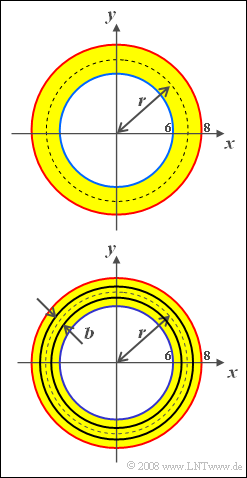We consider circles of different sizes:
- The radius r and the area A can be thought of as interdependent random variables.
- It is assumed that the radius is restricted to the area 6≤r≤8 .
In the sketch above, the area in which such circles (all with center at coordinate origin) can lie is marked in yellow. Furthermore, it can be assumed that the radius in this interval is uniformly distributed:
- fr(r)={0.5for6≤r≤8,0else.
From subtask (5) narrow circular rings with center radius r and width b are considered (lower sketch):
- The area of such a circular ring is denoted by R.
- The possible center radii r are again uniformly distributed between 6 and 8.
- The circular ring width is b=0.1.
Hints:
- The exercise belongs to the chapter Exponentially distributed random variables.
- In particular, reference is made to the page Transformation of random variables.
Questions
Solution
- From this, with r=6 for the minimum value:
- Amin=113.09_.
(2) Correspondingly, with r=8 for the maximum value:
- Amax=201.06_.
(3) The simplest way to solve this problem is as follows:
- mA=E[A]=E[g(r)]=∫+∞−∞g(r)⋅fr(r)dr.
- With g(r)=π⋅r2 and fr(r)=1/2 in the range of 6 ... 8 obtains:
- mA=∫861/2⋅π⋅r2dr=π6⋅(83−63)=154.98_.
(4) The PDF of the transformed random variable A is:
- fA(A)=fr(r)|g′(r)||r=h(y)=√A/π.
- In the range between Amin=113.09 and Amax=201.06 then holds:
- fA(A)=1/22⋅π⋅r|r=√A/π=14⋅√A⋅π.
- The probability we are looking for is obtained by integration:
- Pr(A>150)=∫Amax15014⋅√A⋅πdA=2⋅√A4⋅√π|Amax150.
- The upper limit of integration yields the value 4 and the lower limit 3.455. This yields the probability we are looking for:
- Pr(A>150)=54.5%_.
(5) For the circular ring area R holds for a given radius r:
- R=(r+b/2)2⋅π−(r−b/2)2⋅π=2⋅π⋅r⋅b.
- There is thus a linear relationship between R and r .
- That is: R is also uniformly distributed independently of the width b as long as b≪r.
- For the minimum value holds:
- Rmin=2π⋅6⋅0.1≈3.77_.
(6) Accordingly, the maximum value is:
- Rmax=2π⋅8⋅0.1≈5.03_.
(7) Due to the linear relationship between R and r the mean radius r=7 also leads to the mean circular ring area:
- E[R]=2π⋅7⋅0.1≈4.4_.
